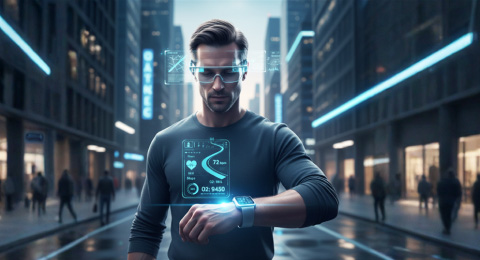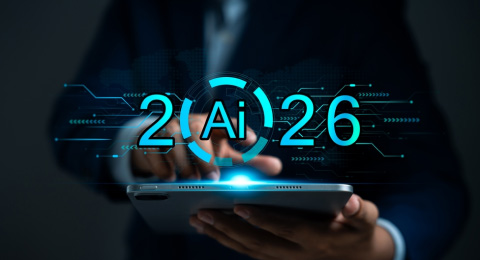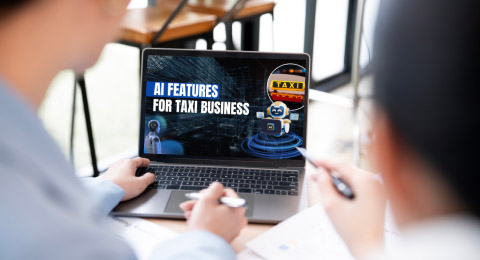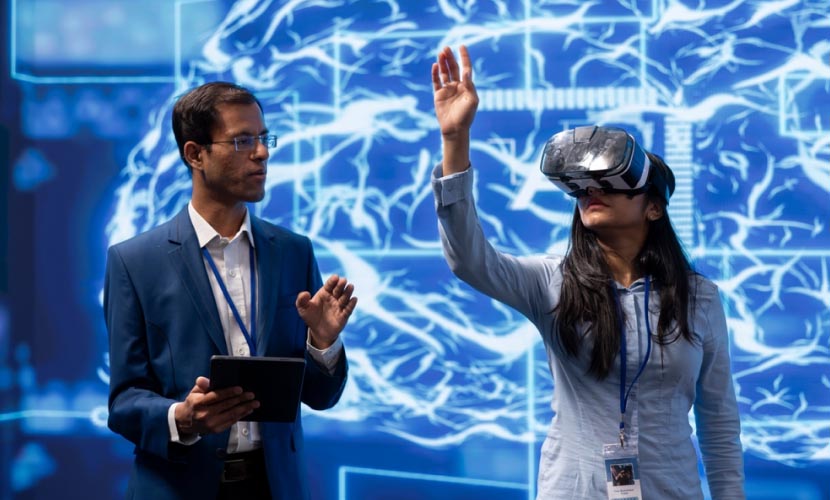
AI in virtual reality is changing the way people experience the digital world. It is no longer limited to games and entertainment. Industries like healthcare, education, real estate, and manufacturing are utilizing its power to simulate VR environments for enhanced user experience.
- What is AI in Virtual Reality?
- Exploring the Top Benefits of AI in Virtual Reality
- Use Cases of AI in Virtual Reality
- Autonomous and Self-Driving Vehicles
- Predictive Maintenance and Diagnostics
- AI-Enabled Smart Manufacturing
- Connected Vehicles and Smart Mobility
- AI in Insurance and Customer Support
- AI-Driven Training and Simulations
- Smart Gaming Environments
- Healthcare and Therapy
- Retail and E-Commerce
- Education and Skill Development
- Challenges and Solutions of AI in Virtual Reality
- Implementation Roadmap for Integrating AI-Powered Virtual Reality
- Future of AI in Virtual Reality
- Conclusion
- FAQs
This article covers the potential impact of AI-driven VR in the business world so that aspiring entrepreneurs can take prompt action before it is too late.
What is AI in Virtual Reality?
AI in virtual reality is the use of artificial intelligence to make virtual environments smarter and more interactive. It helps VR systems understand user behavior, respond in real time, and create more realistic experiences.
When it’s time to create virtual environments that think and react like the real world, AI comes into the picture. Whether it’s about gaming or corporate training, AI can analyze user behavior and dynamically change VR environments for an immersive experience.
The use of AI in VR is supported by four main technologies, as mentioned below.
- Machine learning: Allows AI to learn from user actions and improve VR environments with realistic responses
- Natural language processing (NLP): Makes it possible for users to communicate with virtual characters in real time
- Computer vision: Empowers AI to track user body movements to control avatars with that gesture
- Data analytics: Studies and applies consumer knowledge to change virtual trips as and when required.
Businesses are using AI-powered VR to help customers experience the product or service before they purchase. AI-driven VR simulations are also more effective in employee training than traditional methods.
Exploring the Top Benefits of AI in Virtual Reality

AI takes virtual reality far beyond visual effects. It adds intelligent, responsive, and humane interactions to VR. Let’s understand the benefits of such environments that learn, predict, and evolve with users.
Enhanced Realism Through Predictive Modeling
AI predicts how users move and how environments should react. It studies motion patterns, adjusts lighting, and modifies object behavior to create lively digital environments. Machine learning algorithms also Businesses are using AI-powered VR to help customers experience the product or service before they purchase. AI-driven VR simulations are also more effective in employee training than traditional methods.
Personalized and Adaptive User Experiences
AI studies user interaction, choices made, and even users’ heart rate or gaze. It adapts the VR environment to match their behavior and comfort level. This creates a sense of personal connection inside virtual spaces. For businesses, this means higher engagement and stronger retention rates as users feel seen and understood.
Improved Content Creation Efficiency with AI Tools
AI accelerates the development process in VR. It can create 3D models, animate characters, and design entire scenes automatically. Low manual effort and automation reduce development cycles. As a result, companies can launch immersive VR experiences quickly at a low cost.
Quality Insights for Training and Simulations
AI tracks how users perform in VR training. It measures their accuracy and reaction speed to make decisions in real time. Developers use these insights to refine VR programs for better outcomes. That’s how corporate training, healthcare, and defense VR programs prepare people for complex and risky situations.
AI in VR is about creating experiences that grow with users. Let’s now explore the real-world use cases of AI in virtual reality and how businesses are applying them today.
Use Cases of AI in Virtual Reality
Let’s take a look at some use cases of AI shaping the VR technology in different industries.
Autonomous and Self-Driving Vehicles
AI is playing a massive role in the development of autonomous and self-driving vehicles. It is generating virtual environments that allow manufacturers to thoroughly test vehicles in a completely safe manner.
AI is also behind powering perception systems that can spot objects, people, and signs on the road. It can guide the logic that determines how the car should react to any given situation, including complex traffic. In short, AI now has the ability to take full control of the vehicle for autonomous driving.
Predictive Maintenance and Diagnostics
With AI-powered VR simulations, engineers can now inspect any machine in the vehicle in a virtual environment. AI reads sensor data from the actual equipment and highlights potential faults inside. That saves a lot of hassle.
Engineers can also use this virtualization to identify wear or damage inside the vehicle. For them, it’s a hassle-free way to do predictive maintenance without opening up the parts physically.
AI-Enabled Smart Manufacturing
AI and VR are redefining precision and speed in smart manufacturing. With the help of computer vision, engineers can test the layout on the digital version of the production floor before going live. Further, AI adds intelligence to this setup. It predicts when equipment might fail and suggests the best way to fix it.
With AI-powered VR simulations, manufacturers can safely train workers and plan maintenance without halting production.
Connected Vehicles and Smart Mobility
AI can enable cars to communicate with each other and with the surrounding infrastructure. This is known as Vehicle-to-Everything or V2X communication. It’s able to predict traffic flow and provide instant suggestions for better routes. AI can also manage the coordination of traffic lights, parking systems, and fleets.
AI in Insurance and Customer Support
AI can analyze the driver behavior in VR sessions and recommend better insurance policies. AI-powered VR systems can even simulate accident or damage cases to automate claims processing and detect fraudulent activity in real time.
AI-Driven Training and Simulations
AI-powered simulations in VR provide completely safe and risk-free training environments for military pilots, surgeons, engineers, and other high-stakes professions. It allows them to practice complex tasks. Meanwhile, AI studies their behavior to adjust training modules for better skill retention.
Smart Gaming Environments
When it comes to virtual reality gaming, AI can control the behavior of non-player characters and change the difficulty level of the game to match their actions. By predicting a player’s intent, it can tweak challenges dynamically. Games that are built on this principle make use of immersive role-playing and real-time physics-adaptation, all powered by AI.
Healthcare and Therapy
Healthcare is also getting a huge boost from AI-powered virtual simulations, especially in rehabilitation, pain management, and mental health therapy. It observes the movement and emotions of patients and adjusts the exercises or scenery so that they recover better. With cognitive and exposure therapy, it tracks the progress of patients and makes sure they stay comfortable when facing what scares them.
Retail and E-Commerce
The e-commerce industry can provide virtual sessions to help customers try new clothes, visualize the furniture in their homes, or walk through digital stores. AI takes a good look at your preferences and recommends things that suit your style. It also lays out customized storefronts that improve conversion rates for digital sellers.
Education and Skill Development
AI-powered VR can turn classrooms into smart learning zones. For example, virtual teachers can teach students and automatically adjust the teaching level to their learning speed. Students have fun learning through gamified lessons and get instant feedback that boosts memory.
Want to Harness the Power of AI in Virtual Reality to Build Immersive Business Solutions? Talk to Our AI Development Experts.
Challenges and Solutions of AI in Virtual Reality

The use of AI in virtual reality may bring the following challenges. They can distract your vision unless you know how to overcome them.
Data Privacy Concerns
It collects sensitive user data like gestures, voice, and emotional responses. What if this information falls into the wrong hands?
Solution:
Always encrypt data and store it inside secure cloud storage. Only trusted individuals should have access to the information. This builds user confidence in the system.
High Computational Costs
There is a requirement for high processing power and memory to run AI inside VR environments. For small organizations, it means increased system costs and slowed performance.
Solution:
Shift heavy workloads to the cloud. Additionally, use edge computing to handle tasks locally. It will add speed to data rendering. This setup lowers pressure on hardware and therefore improves overall efficiency.
Ethical and Psychological Impacts
Immersive AI-powered VR environments can influence user emotions and choices. That said, a poorly designed system may trigger discomfort or bias.
Solution:
It is very important to follow ethical AI principles. Keep algorithms transparent. Design them with an aim to promote fairness and emotional safety. That will, needless to say, require periodic auditing algorithms for ethical alignment.
Integration Complexity
Sometimes, AI and VR do not blend well. There can be compatibility issues because of different platforms, tools, and data formats.
Solution:
That’s why experienced players use modular architectures and pre-trained AI frameworks. Once you achieve a smooth integration, it gets faster, easier, and more flexible to use applications.
Implementation Roadmap for Integrating AI-Powered Virtual Reality
How can you turn an AI-powered VR concept into a competitive advantage? You need a structured execution.
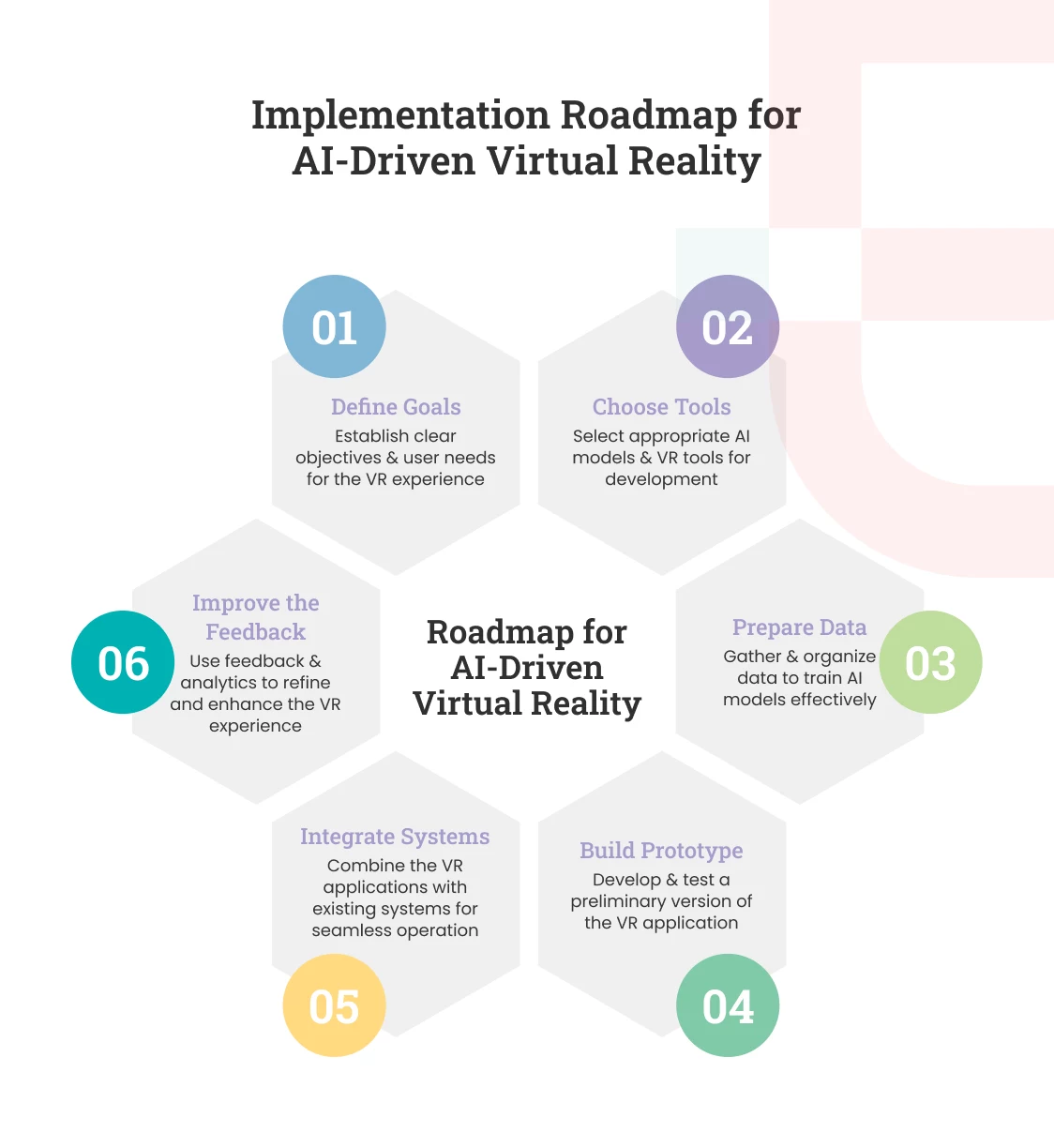
Step 1: Define Objectives and User Requirements
First, you need clarity about your strategic purpose of using AI in VR. Is it for simulation, training, or customer engagement? This will help you create the perfect custom AI solution, tailored for your organizational needs.
During the process of finding the answer,
- Identify core business KPIs that will drive the maximum impact
- Define user personas, workflows, and data interaction points
- Map user experience, operational efficiency, and performance outcomes.
Now, you have created a measurable foundation for investment and scaling.
Step 2: Select the Right AI Models and VR Platforms
The technical backbone of your AI-VR system will decide its fate in the long term.
That’s why responsible developers prefer AI models that support predictive learning and personalization. Now, for the VR platform, go for the one that offers stable performance and integration support. VR engines like Unreal or Unity are popular as they smoothly support AI plug-ins and high-fidelity rendering.
Step 3: Data Collection and Preprocessing
If you want the AI model to thrive, feed it with clean, contextual data. It will require you to collect data from multiple sources. It can be from sensors, user interactions, or past records. Next, clean the data to remove any errors or bias. Usually, companies use ETL pipelines for cleansing and normalization. Before you feed it into the AI, apply data labeling frameworks for object recognition and gesture mapping.
Step 4: Prototype Development and Testing
Before you go full scale, build a small prototype first. Why is it important? It will help you test how AI and VR work together in real scenarios. What if a system weakness starts impacting the results? It’s better to test early on the prototype and refine performance to ensure the outcome brings the best user experience.
Step 5: Integration with Existing Infrastructure
Once the prototype receives a green flag, it’s time to connect the AI-VR system with the existing system. The biggest challenge here is to maintain a smooth data flow and system communication. In this regard, edge processing helps in achieving low-latency interactions.
Step 6: Continuous Optimization through Feedback and Analytics
How can you know if the integration works well for users? You collect user feedback after deployment. Analyze performance data to find gaps and new opportunities. Use these insights to upgrade features and enhance user experience continuously.
For example, automate optimization workflows through continuous integration (CI) and machine learning operations (MLOps). This transforms the AI-VR ecosystem into a self-learning, adaptive platform.
Future of AI in Virtual Reality
As both technologies are evolving faster, their combined power is about to reshape how people live, learn, and work inside digital spaces. Here are a few trends that will define what comes next.
Generative AI for Automated 3D Asset Creation
In the near future, generative AI will be able to build entire virtual universes on its own. It will make use of generative adversarial networks (GANs) and diffusion models to learn and create brand-new buildings, landscapes, and even human avatars in just a few seconds. This will cut down development time and cost to a great extent.
Hyper-Personalized Virtual Worlds
One of the most hyped AI trends is that it will soon be able to gauge the depths of human emotions, gestures, heart rate, and expressions. Once it starts to understand how users feel, it can even adjust the VR environment to suit their mood. Such adaptive environments will prove to be useful for mental health therapy.
AI-Powered Metaverse Development
The metaverse will depend on AI and VR to stay smart and scalable. VR can create immersive spaces where people can work, play, and connect. AI can turn these spaces smart and adaptive. For example, it can design 3D worlds automatically, manage virtual environments, and ensure smooth interaction among users. Together, these systems will create an intelligent, self-evolving metaverse that grows with its users.
Conclusion
The fusion of AI in VR is all about building intelligent worlds that learn, adapt, and evolve with human behavior. This powerful combination is redefining how people work, learn, heal, and connect.
For entrepreneurs, this is the right moment to act. The industries that can leverage AI-powered VR early will set the standard for innovation and customer engagement.
However, it needs a responsible approach. You have to balance creativity with ethics and data transparency. Partnering with a trusted AI development services company can help transform bold ideas into scalable, real-world solutions.
The next big revolution is already here. Are you ready to build it first?
FAQs
AI makes VR systems react more like actual life. Instead of just following scripts, VR systems think, learn, and adapt to user behaviors in real time. As a result, everything flows smoothly and turns VR into an interactive and adaptive space.
AI-powered VR is now used in many industries, such as healthcare, education, manufacturing, retail, defense, and real estate.
In an AI-powered VR system, game characters can learn from player actions. AI can also tweak graphics and movement to make the virtual world feel more real. It studies what players enjoy and adapts the story or level difficulty. This keeps every session fresh and more engaging.
The primary challenge of using AI in VR is about data privacy, as the technology collects very personal user information, like movement and speech. Second, the maintenance cost of the VR system hardware and AI software is very expensive. Integrating AI and VR systems together can also be a problem due to several compatibility issues.
Now, the potential of AI in VR is looking very promising. AI is going to analyze the minds of users to learn how they interact and understand their emotions and desires. This will help AI-powered VR simulations to train employees, hold meetings, and run complex simulations with more human touch.
Yes, AI-powered VR experiences can be highly customized. The technology watches how users move, talk, and react within the virtual environment. Based on all that information, it adjusts the settings, recommends content, or changes the difficulty level. As a result, each experience feels more personal.


